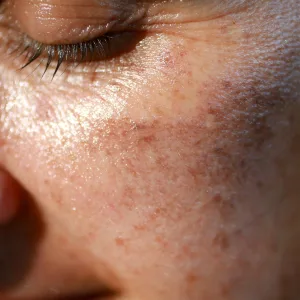Isolated areas of the skin or all of the skin can be affected by hyperpigmentation. Typical examples of locally restricted hyperpigmentation are freckles, birthmarks and age spots.
Cause
Melanin production can be stimulated by a variety of factors. These include UV light (exposure to the sun), hormonal changes, e.g. during pregnancy, metabolic disorders and taking certain medicines. In addition, inflammation of the skin may subsequently trigger hyperpigmentation.
One of the main causes of hyperpigmentation is exposure to sunlight, which strongly stimulates melanin production in the skin. Melanin acts as a natural defence against UV rays. This is why the skin tans in darker skin types (skin types 3-6 according to Fitzpatrick). Very light skin types (skin types 1 and 2) with an extremely low melanin index do not tan or tan very slightly and therefore burn more frequently. However, this natural tanning process can become unbalanced with excessive sun exposure, which can lead to uneven pigmentation. The oxidative stress caused by UVA and UVB rays also plays a role, as it favours both the development of hyperpigmentation and premature skin ageing.
Options for treatment
There are now a variety of options for treating hyperpigmentation caused by melanin. For example, the application of creams specifically developed for this purpose can render the spots paler or make them disappear. In addition, laser treatment or other cosmetic procedures can be used to treat hyperpigmentation.
